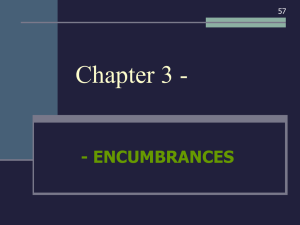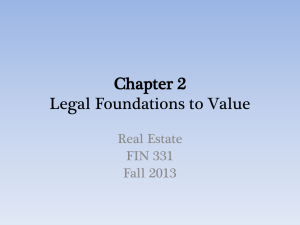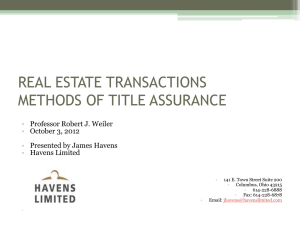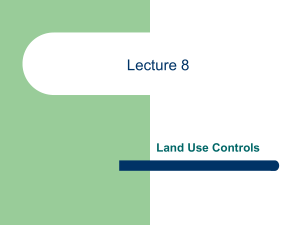Types of Liens Attachment liens
advertisement
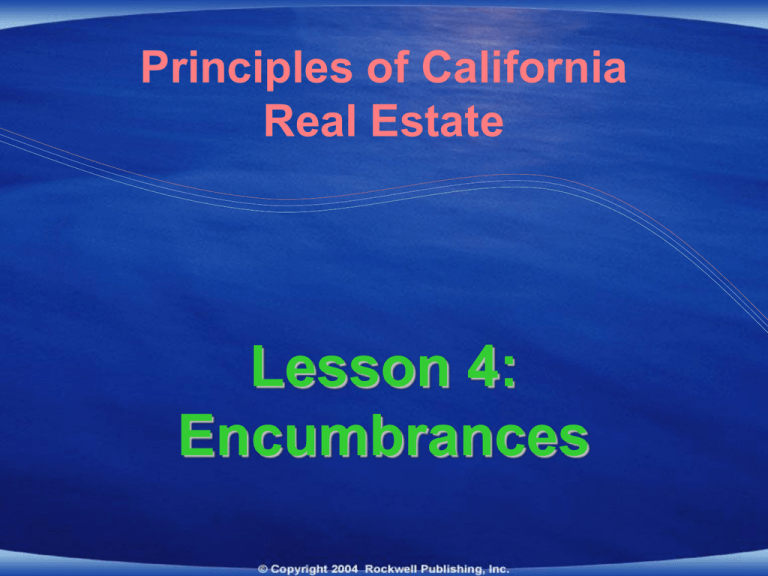
Principles of California Real Estate Lesson 4: Encumbrances Encumbrances Encumbrance: A nonpossessory interest in real property, held by someone other than the owner. Encumbrances Encumbrance: A nonpossessory interest in real property, held by someone other than the owner. Does not give ownership or right to exclusive possession. Financial vs. Non-financial Encumbrances Encumbrances are either: financial (liens) or Financial vs. Non-financial Encumbrances Encumbrances are either: financial (liens) or non-financial (easements, private restrictions, etc.) Liens Security interest Security interest: A creditor’s interest in property based on a lien, which makes the property security (collateral) for the owner’s debt. Liens Security interest Security interest: A creditor’s interest in property based on a lien, which makes the property security (collateral) for the owner’s debt. If property owner fails to repay debt, secured creditor may foreclose. Liens Security interest Security interest: A creditor’s interest in property based on a lien, which makes the property security (collateral) for the owner’s debt. If property owner fails to repay debt, secured creditor may foreclose. Property burdened by lien may be sold, but new owner takes title subject to lien. Liens Voluntary vs. involuntary Voluntary lien: Property owner voluntarily grants lien to creditor. Liens Voluntary vs. involuntary Voluntary lien: Property owner voluntarily grants lien to creditor. Example: mortgage Liens Voluntary vs. involuntary Voluntary lien: Property owner voluntarily grants lien to creditor. Example: mortgage Involuntary (statutory) lien: Lien given to creditor by operation of law, without property owner’s consent. Liens Voluntary vs. involuntary Voluntary lien: Property owner voluntarily grants lien to creditor. Example: mortgage Involuntary (statutory) lien: Lien given to creditor by operation of law, without property owner’s consent. Example: tax lien Liens General vs. specific General lien: Lien attaches to all of the debtor’s real property. Example: judgment lien Specific lien: Lien attaches only to a specific piece of real property, not to everything debtor owns. Example: mortgage Liens Types of liens Mortgages Deeds of trust Mechanic’s liens Judgment liens Attachment liens RE Property Tax liens Special assessment liens Types of Liens Mortgages Mortgage: A lien created by contract between a property owner and a lender. Types of Liens Mortgages Mortgage: A lien created by contract between a property owner and a lender. Owner (Borrower) = Mortgagor Lender = Mortgagee Types of Liens Mortgages Mortgage: A lien created by contract between a property owner and a lender. Owner (Borrower) = Mortgagor Lender = Mortgagee Borrower gives lender mortgage as security for repayment of loan, with property serving as collateral. Types of Liens Deeds of trust Deed of trust serves same purpose as mortgage but has different foreclosure procedures. Types of Liens Deeds of trust Deed of trust serves same purpose as mortgage but has different foreclosure procedures. Borrower = Trustor or Grantor Lender = Beneficiary Neutral third party = Trustee (Trustee handles foreclosure, if necessary.) Types of Liens Mechanic’s liens Mechanic’s lien: Lien attaching to real property on which construction work was performed. Types of Liens Mechanic’s liens Mechanic’s lien: Lien attaching to real property on which construction work was performed. Can be claimed by anyone providing labor, materials, or services. Types of Liens Mechanic’s liens Mechanic’s lien: Lien attaching to real property on which construction work was performed. Can be claimed by anyone providing labor, materials, or services. If owner fails to pay as agreed, lienholder can foreclose on property. Types of Liens Mechanic’s liens Mechanic’s lien: Lien attaching to real property on which construction work was performed. Can be claimed by anyone providing labor, materials, or services. If owner fails to pay as agreed, lienholder can foreclose on property. Also called a construction lien or materialman’s lien. Mechanic’s Liens Preliminary notice Must give owner preliminary notice of right to claim lien within 20 days of starting to provide services or materials. Mechanic’s Liens Preliminary notice Must give owner preliminary notice of right to claim lien within 20 days of starting to provide services or materials. Notice unnecessary if lien claimant has direct contract with owner (usually true for general contractor). Mechanic’s Liens Deadlines Once project is completed (or all work has stopped for 30 days), owner has 10 days to file a notice of completion. Mechanic’s Liens Deadlines Once project is completed (or all work has stopped for 30 days), owner has 10 days to file a notice of completion. Once notice of completion is filed, mechanic’s lien must be filed for recording within 30 days. Exception: general contractors have 60 days. Mechanic’s Liens Deadlines If no notice of completion is filed, mechanic’s lien may be filed up to 90 days after work has stopped. Mechanic’s Liens Deadlines If no notice of completion is filed, mechanic’s lien may be filed up to 90 days after work has stopped. If deadline is missed, lien cannot be filed. Creditor can still sue owner, but can’t foreclose on property to collect debt. Mechanic’s Liens Deadlines Once filed, mechanic’s lien will expire if lienholder doesn’t start foreclosure proceedings within 90 days. Types of Liens Judgment liens Judgment lien: A lien that results from a financial judgment against the losing party in a lawsuit (the judgment debtor). Types of Liens Judgment liens Judgment lien: A lien that results from a financial judgment against the losing party in a lawsuit (the judgment debtor). Attaches to judgment debtor’s property. Types of Liens Judgment liens Judgment lien: A lien that results from a financial judgment against the losing party in a lawsuit (the judgment debtor). Attaches to judgment debtor’s property. If judgment is not paid, court may order debtor’s property sold, to satisfy judgment. Types of Liens Judgment liens A judgment lien: attaches automatically to all the debtor’s property in county where lawsuit took place Types of Liens Judgment liens A judgment lien: attaches automatically to all the debtor’s property in county where lawsuit took place can attach to new property acquired by the debtor Types of Liens Judgment liens A judgment lien: attaches automatically to all the debtor’s property in county where lawsuit took place can attach to new property acquired by the debtor can attach to property in other counties if the creditor files an abstract of judgment in those counties Types of Liens Attachment liens Attachment lien: A lien used to prevent a defendant from selling property that could be subject to a future judgment. Types of Liens Attachment liens Attachment lien: A lien used to prevent a defendant from selling property that could be subject to a future judgment. Court issues writ of attachment. Types of Liens Attachment liens Attachment lien: A lien used to prevent a defendant from selling property that could be subject to a future judgment. Court issues writ of attachment. Writ is recorded so that anyone buying the property takes title subject to plaintiff’s lien. Types of Liens Attachment liens Lis pendens: Legal document filed by plaintiff in lawsuit, notifying anyone who purchases specified property about a pending lawsuit that may affect title. Types of Liens Attachment liens Lis pendens: Legal document filed by plaintiff in lawsuit, notifying anyone who purchases specified property about a pending lawsuit that may affect title. Just provides notice; doesn’t create lien. Types of Liens Attachment liens Lis pendens: Legal document filed by plaintiff in lawsuit, notifying anyone who purchases specified property about a pending lawsuit that may affect title. Just provides notice; doesn’t create lien. If property is sold, new owner is bound by any resulting judgment. Types of Liens Property tax liens Property tax lien: The lien created by general real estate taxes. Types of Liens Property tax liens Property tax lien: The lien created by general real estate taxes. Attaches only to the property being taxed. Types of Liens Property tax liens Property tax lien: The lien created by general real estate taxes. Attaches only to the property being taxed. Allows government to foreclose and collect delinquent taxes from the proceeds of the foreclosure sale. Types of Liens Special assessment liens Special assessment lien: A lien based on a special assessment levied to pay for specific improvements such as street paving or sewer lines. Types of Liens Special assessment liens Special assessment lien: A lien based on a special assessment levied to pay for specific improvements such as street paving or sewer lines. Attaches only to properties that are subject to the special assessment (because they will benefit from the project). Types of Liens IRS liens IRS lien: A general lien that attaches to all property belonging to a taxpayer who has failed to pay federal income taxes. Summary Basic definitions Encumbrance Mechanic’s lien Lien Judgment lien Mortgage Attachment lien Deed of trust Tax lien Lien Priority Lien priority: Determines the order in which lienholders will be paid if one lienholder forecloses on a property with multiple liens. Lien Priority Foreclosure sale proceeds are paid to each lienholder in order of priority. Lien Priority Foreclosure sale proceeds are paid to each lienholder in order of priority. Any surplus goes to foreclosed property owner. Lien Priority Foreclosure sale proceeds are paid to each lienholder in order of priority. Any surplus goes to foreclosed property owner. If proceeds aren’t enough to pay off all liens, lienholders with lowest priority are not paid. Lien Priority Recording date Recording date: The date a lien was filed for recording in county’s public record. Lien Priority Recording date Recording date: The date a lien was filed for recording in county’s public record. Determines lien priority except for: Lien Priority Recording date Recording date: The date a lien was filed for recording in county’s public record. Determines lien priority except for: property tax and assessment liens (always have higher priority) Lien Priority Recording date Recording date: The date a lien was filed for recording in county’s public record. Determines lien priority except for: property tax and special assessment liens (always have higher priority) mechanic’s liens (priority based on date work began) Liens Homestead Law Homeowners have limited protection against judgment lien foreclosure. Liens Homestead Law Homeowners have limited protection against judgment lien foreclosure. Homestead law does not apply to: Liens Homestead Law Homeowners have limited protection against judgment lien foreclosure. Homestead law does not apply to: voluntary liens (mortgages, deeds of trust) Liens Homestead Law Homeowners have limited protection against judgment lien foreclosure. Homestead law does not apply to: voluntary liens (mortgages, deeds of trust) mechanic’s liens Liens Homestead Law Homeowners have limited protection against judgment lien foreclosure. Homestead law does not apply to: voluntary liens (mortgages, deeds of trust) mechanic’s liens liens resulting from failure to pay child support or spousal maintenance Liens Homestead Law Homestead: Dwelling occupied by the owner, plus land and any attached buildings. Liens Homestead Law Homestead: Dwelling occupied by the owner, plus land and any attached buildings. Owner may claim homestead protection after foreclosure proceedings have started, or by filing a declaration with the county recorder. Liens Homestead Law A person can have only one homestead at a time. Liens Homestead Law A person can have only one homestead at a time. Homestead protection terminates when: owner files declaration of homestead on different property Liens Homestead Law A person can have only one homestead at a time. Homestead protection terminates when: owner files declaration of homestead on different property original property is sold Liens Homestead Law A person can have only one homestead at a time. Homestead protection terminates when: owner files declaration of homestead on different property original property is sold declaration of abandonment is filed Liens Homestead Law A person can have only one homestead at a time. Homestead protection terminates when: owner files declaration of homestead on different property original property is sold declaration of abandonment is filed If the homestead owner dies, protection continues for family members still living on the property. Homestead Law Exemption Homestead makes part of homeowner’s equity exempt from claims. Homestead Law Exemption Homestead makes part of homeowner’s equity exempt from claims. Judgment creditor can’t foreclose unless property’s net value exceeds the exemption. Homestead Law Exemption Homestead makes part of homeowner’s equity exempt from claims. Judgment creditor can’t foreclose unless property’s net value exceeds the exemption. Net value = Market value minus amount of higher-priority liens Homestead Law Exemption Exemption amounts: $50,000 standard exemption Homestead Law Exemption Exemption amounts: $50,000 standard exemption $75,000 if debtor is part of a family unit Homestead Law Exemption Exemption amounts: $50,000 standard exemption $75,000 if debtor is part of a family unit $150,000 if debtor is: 1) over 65, 2) over 55 and low income, 3) married and low income, or 4) unable to work because of a disability Homestead Law Sale of home Homestead protection also covers sale proceeds. Homestead Law Sale of home Homestead protection also covers sale proceeds. Homestead owner has a six-month grace period to use the money to buy a new home. Summary Lien Priority and Foreclosure Lien priority Voluntary liens Tax liens Construction liens Surplus Homestead exemption Encumbrances Non-financial encumbrances While liens usually affect only owner’s title (not use of property), non-financial encumbrances commonly affect both title and use. Encumbrances Non-financial encumbrances While liens usually affect only owner’s title (not use of property), non-financial encumbrances commonly affect both title and use. Non-financial encumbrances include: easements profits private restrictions Non-financial Encumbrances Easements Easement: A right to use someone else’s land for a particular purpose. Non-financial Encumbrances Easements Easement: A right to use someone else’s land for a particular purpose. Easement holder may use property in some specific, limited way, but may not take possession of the property. Easements Types of easements Two basic types of easements: easements appurtenant easements in gross Types of Easements Easements appurtenant Easement appurtenant: Burdens one piece of land (servient tenement) for benefit of another piece of land (dominant tenement). Types of Easements Easements appurtenant Easement appurtenant: Burdens one piece of land (servient tenement) for benefit of another piece of land (dominant tenement). Owner of dominant tenement is dominant tenant. Types of Easements Easements appurtenant Easement appurtenant: Burdens one piece of land (servient tenement) for benefit of another piece of land (dominant tenement). Owner of dominant tenement is dominant tenant. Owner of servient tenement is servient tenant. Types of Easements Easements appurtenant Easement appurtenant runs with the land. It continues to exist even if either the dominant or the servient tenement is sold. Types of Easements Easements appurtenant Easement appurtenant runs with the land. It continues to exist even if either the dominant or the servient tenement is sold. The benefit and the burden are automatically passed on to all subsequent owners. Types of Easements Easements in gross Easement in gross: Benefits particular person rather than parcel of land. No dominant tenement, only servient tenement (parcel burdened by easement). Types of Easements Easements in gross Easement in gross: Benefits particular person rather than parcel of land. No dominant tenement, only servient tenement (parcel burdened by easement). Benefit is considered a personal right, cannot be assigned to someone else. Types of Easements Easements in gross Easement in gross: Benefits particular person rather than parcel of land. No dominant tenement, only servient tenement (parcel burdened by easement). Benefit is considered a personal right, cannot be assigned to someone else. Burden of easement in gross still runs with the land. Easements in Gross Commercial easements Commercial easement: Easement in gross held by a company for business purposes. Easements in Gross Commercial easements Commercial easement: Easement in gross held by a company for business purposes. Exception to rule: Commercial easement in gross can be assigned from one entity to another. Easements in Gross Commercial easements Commercial easement: Easement in gross held by a company for business purposes. Exception to rule: Commercial easement in gross can be assigned from one entity to another. Example: Easement to install and maintain utility lines. Summary Easements Easement Easement appurtenant Running with the land Easement in gross Commercial easement in gross Easements Creating easements Easements are created by: express grant express reservation implication prescription reference to a recorded plat dedication condemnation Creating Easements Express grant Property owner deliberately grants someone else an easement on her property. Creating Easements Express grant Property owner deliberately grants someone else an easement on her property. May be purchased by the person needing the easement. Creating Easements Express grant Property owner deliberately grants someone else an easement on her property. May be purchased by the person needing the easement. May be created when one part of a larger property is sold. Creating Easements Express grant Grant of easement must be in writing and signed by grantor (required by statute of frauds). Creating Easements Express grant Grant of easement must be in writing and signed by grantor (required by statute of frauds). Document creating easement should always be recorded to provide public notice. Creating Easements Express reservation Owner selling part of her property may reserve easement against parcel she’s selling, to benefit parcel she’s keeping. Creating Easements Express reservation Owner selling part of her property may reserve easement against parcel she’s selling, to benefit parcel she’s keeping. Easement by express reservation must be in writing, and the document should be recorded. Creating Easements Implication Called easement by implication, implied easement, or easement by necessity. Creating Easements Implication Called easement by implication, implied easement, or easement by necessity. Example: Part of a larger parcel is sold, but grantor neglects to create easement in deed, leaving one of the parcels without an access route. An easement would be created by implication. Creating Easements Implication Requirements for an easement by implication: must be reasonably necessary for enjoyment of dominant tenement Creating Easements Implication Requirements for an easement by implication: must be reasonably necessary for enjoyment of dominant tenement apparent prior use of the easement Creating Easements Prescription Easement by prescription: An easement established by using someone else’s property without the owner’s permission. Also called a prescriptive easement. Creating Easements Prescription Requirements: Open and notorious (conspicuous) use Creating Easements Prescription Requirements: Open and notorious (conspicuous) use Hostile use Creating Easements Prescription Requirements: Open and notorious (conspicuous) use Hostile use Claim of right or color of title Creating Easements Prescription Requirements: Open and notorious (conspicuous) use Hostile use Claim of right or color of title Continuous and uninterrupted for 5 years Creating Easements Prescription Requirements: Open and notorious (conspicuous) use Hostile use Claim of right or color of title Continuous and uninterrupted for 5 years If property taxes are assessed separately on easement, easement claimant must pay them during five-year period. Creating Easements Reference to a recorded plat When land is subdivided, purchasers acquire easements to use all roads and alleys shown in recorded plat map. Creating Easements Dedication Dedication: Private property owner transfers interest in property to government. Creating Easements Dedication Dedication: Private property owner transfers interest in property to government. Example: Philanthropist dedicates his land to city for a park, or dedicates an easement across his land for access to the park. Creating Easements Dedication Dedication may be: voluntary (easement should be put into writing and recorded), or Creating Easements Dedication Dedication may be: voluntary (easement should be put into writing and recorded), or involuntary (by implication) Creating Easements Dedication Dedication may be: voluntary (easement should be put into writing and recorded), or involuntary (by implication) If public uses private property over a long period without owner’s permission, easement may be created by implied dedication. Creating Easements Condemnation Condemnation: Legal process used to force private owner to sell land or an easement to the government. Creating Easements Condemnation Condemnation: Legal process used to force private owner to sell land or an easement to the government. Property or easement must be used for a public purpose. Creating Easements Condemnation Condemnation: Legal process used to force private owner to sell land or an easement to the government. Property or easement must be used for a public purpose. Property owner must be compensated. Summary Creating Easements Express grant Express reservation Implication Prescription Reference to recorded plat Dedication Condemnation Terminating Easements Easements can be terminated by: release merger failure of purpose abandonment prescription Terminating Easements Release Release: When someone who has a specified interest in a property gives it up to someone else. Terminating Easements Release Release: When someone who has a specified interest in a property gives it up to someone else. Easement is terminated if dominant tenant releases servient tenant from it in writing. Terminating Easements Release Release: When someone who has a specified interest in a property gives it up to someone else. Easement is terminated if dominant tenant releases servient tenant from it in writing. Dominant tenant executes and records quitclaim deed in favor of servient tenant. Terminating Easements Merger Merger: When two adjacent properties come under the same ownership. Terminating Easements Merger Merger: When two adjacent properties come under the same ownership. If the same party becomes owner of both the dominant and the servient property, easement terminates by merger. Terminating Easements Merger Merger: When two adjacent properties come under the same ownership. If the same party becomes owner of both the dominant and the servient property, easement terminates by merger. You can’t have an easement against your own property. Terminating Easements Failure of purpose Easement is a right to use another’s property for a particular purpose, and once that purpose no longer exists, easement is terminated. Terminating Easements Abandonment Abandonment: Easement holder (dominant tenant) does something indicating intent to stop using easement forever. Terminating Easements Abandonment Abandonment: Easement holder (dominant tenant) does something indicating intent to stop using easement forever. General rule: Non-use is not sufficient to indicate abandonment. Terminating Easements Abandonment Abandonment: Easement holder (dominant tenant) does something indicating intent to stop using easement forever. General rule: Non-use is not sufficient to indicate abandonment. Exception: Servient tenant can sue to have a prescriptive easement terminated after 5 years of non-use. Terminating Easements Prescription Easement is terminated by prescription if servient tenant takes action to prevent dominant tenant from using easement, and is successful for 5 years. Summary Terminating Easements Release Merger Failure of purpose Abandonment Prescription Non-financial Encumbrances Profits Profit: The right to take something from land belonging to someone else. Non-financial Encumbrances Profits Profit: The right to take something from land belonging to someone else. Must be created in writing or by prescription. Non-financial Encumbrances Related concepts Licenses Encroachments Nuisances Non-financial Encumbrances Related concepts Licenses Encroachments Nuisances These are not classified as encumbrances. They affect someone else’s property, but aren’t considered interests in real property. Related Concepts Licenses License: Right to enter and use land belonging to another person. Related Concepts Licenses License: Right to enter and use land belonging to another person. Does not need to be in writing Related Concepts Licenses License: Right to enter and use land belonging to another person. Does not need to be in writing Revocable Related Concepts Licenses License: Right to enter and use land belonging to another person. Does not need to be in writing Revocable Does not create a property interest Related Concepts Licenses License: Right to enter and use land belonging to another person. Does not need to be in writing Revocable Does not create a property interest Not assignable Related Concepts Licenses License: Right to enter and use land belonging to another person. Does not need to be in writing Revocable Does not create a property interest Not assignable Does not run with the land Related Concepts Encroachments Encroachment: Occurs when a physical object from one property intrudes onto neighboring property. Related Concepts Encroachments Encroachment: Occurs when a physical object from one property intrudes onto neighboring property. Most encroachments are unintentional. Related Concepts Encroachments Landowner who believes her property is being encroached upon can sue neighbor. Called an ejectment action. Related Concepts Encroachments Landowner who believes her property is being encroached upon can sue neighbor. Called an ejectment action. Court may order defendant to remove encroachment or pay damages. Related Concepts Encroachments Landowner who believes her property is being encroached upon can sue neighbor. Called an ejectment action. Court may order defendant to remove encroachment or pay damages. Statute of limitations: 3 years. Related Concepts Nuisances Nuisance: Activity on or condition of property that interferes with neighboring owner’s use of her property. Related Concepts Nuisances Nuisance: Activity on or condition of property that interferes with neighboring owner’s use of her property. Private nuisance: Affects a few people, like smell of neighbor’s pet pigs. Related Concepts Nuisances Nuisance: Activity on or condition of property that interferes with neighboring owner’s use of her property. Private nuisance: Affects a few people, like smell of neighbor’s pet pigs. Public nuisance: Affects many landowners, like pollution from nearby factory. Related Concepts Nuisances Property owner affected by a private or public nuisance can sue for: an injunction to stop the nuisance Related Concepts Nuisances Property owner affected by a private or public nuisance can sue for: an injunction to stop the nuisance compensatory damages Related Concepts Nuisances Attractive nuisance doctrine: If property has feature that is dangerous and attractive to children, owner will be liable for any harm resulting to trespassing children. Related Concepts Nuisances Attractive nuisance doctrine: If property has feature that is dangerous and attractive to children, owner will be liable for any harm resulting to trespassing children. Example: an unfenced swimming pool. Summary Profits, Licenses, and Encroachments Profit License Encroachment Nuisance Non-financial Encumbrances Private restrictions Private restrictions restrict how an owner may use her own property. Non-financial Encumbrances Private restrictions Private restrictions restrict how an owner may use her own property. Commonly created when transferring title, to restrict all subsequent owners. Non-financial Encumbrances Private restrictions Private restrictions restrict how an owner may use her own property. Commonly created when transferring title, to restrict all subsequent owners. New restrictions may be stated in deed or recorded at county recorder’s office Non-financial Encumbrances Private restrictions Private restrictions restrict how an owner may use her own property. Commonly created when transferring title, to restrict all subsequent owners. New restrictions may be stated in deed or recorded at county recorder’s office Private restrictions often called deed restrictions or restrictive covenants. Non-financial Encumbrances Private restrictions Private restrictions may also be imposed when there’s no change of ownership. Non-financial Encumbrances Private restrictions Private restrictions may also be imposed when there’s no change of ownership. Sometimes owner will impose restriction on own property in return for payment. Non-financial Encumbrances Private restrictions Private restrictions may also be imposed when there’s no change of ownership. Sometimes owner will impose restriction on own property in return for payment. If put into writing and recorded, private restrictions run with land, just like easements. Private Restrictions CC&Rs Stands for covenants, conditions, and restrictions. Private Restrictions CC&Rs Stands for covenants, conditions, and restrictions. Usually imposed by original developer of residential subdivision. Private Restrictions CC&Rs Stands for covenants, conditions, and restrictions. Usually imposed by original developer of residential subdivision. Recorded, and a reference included in first deed for each lot in subdivision. Private Restrictions CC&Rs Stands for covenants, conditions, and restrictions. Usually imposed by original developer of residential subdivision. Recorded, and a reference included in first deed for each lot in subdivision. Provides constructive notice to subsequent owners of the lot. Private Restrictions CC&Rs CC&Rs allow homeowners to prevent neighbors from doing things that will have a negative effect on property values. Private Restrictions CC&Rs CC&Rs allow homeowners to prevent neighbors from doing things that will have a negative effect on property values. If one owner violates CC&Rs, other owners can file a lawsuit against the violator. Private Restrictions In conflict with zoning Private restrictions may be stricter than public land use controls, such as zoning laws. Private Restrictions In conflict with zoning Private restrictions may be stricter than public land use controls, such as zoning laws. If two restrictions (one public and one private) both address same issue, the more restrictive one usually applies. Private Restrictions Illegal or unconstitutional Private restrictions that violate law or constitutional provisions are not enforceable. Private Restrictions Illegal or unconstitutional Private restrictions that violate law or constitutional provisions are not enforceable. An unenforceable restriction in a deed does not make the deed void. Only the restriction is void. Private Restrictions Illegal or unconstitutional Private restrictions that violate law or constitutional provisions are not enforceable. An unenforceable restriction in a deed does not make the deed void. Only the restriction is void. Any restriction on property owner putting up “For Sale” signs is typically void. Private Restrictions Covenant vs. condition Covenant: Legally enforceable promise to do or not do something. Private Restrictions Covenant vs. condition Covenant: Legally enforceable promise to do or not do something. Violation can result in injunction or damages. Private Restrictions Covenant vs. condition Covenant: Legally enforceable promise to do or not do something. Violation can result in injunction or damages. Condition: Ownership of property depends on compliance with restriction. Private Restrictions Covenant vs. condition Covenant: Legally enforceable promise to do or not do something. Violation can result in injunction or damages. Condition: Ownership of property depends on compliance with restriction. Violator may actually forfeit title to property. Conditions are rare today because this result is so harsh. Private Restrictions Enforcement Restriction may not be enforceable if: owners in subdivision failed to enforce it against other violators Private Restrictions Enforcement Restriction may not be enforceable if: owners in subdivision failed to enforce it against other violators character of neighborhood has changed drastically Private Restrictions Enforcement Restriction may not be enforceable if: owners in subdivision failed to enforce it against other violators character of neighborhood has changed drastically property owner suing to enforce restriction is also in violation Summary Private Restrictions Private restrictions CC&Rs Covenants Conditions
